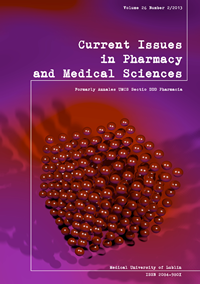Acaricidal effect of some plants on Ixodes ricinus - a pilot study
DOI:
https://doi.org/10.12923/j.2084-980X/26.2/a.06Keywords:
acaricidal effect, Ixodes ricinus, plant extractsAbstract
In the search for natural antiticktide substances, 23 raw materials belonging to 16 plant species were tested. In the study, the behavior of ticks after stimulation with chloroform and methanol plant extracts was observed. All the tested extracts have shown toxicity against Ixodes ricinus. The most toxic appeared to be methanol extracts from Helihrysum arenarium (L.) Moench., Centaurea cyjanus L., Taraxacum officinale Web., Tanacetum vulgare L., Chelidonium maius L. and Armoracia rusticana Gilib. which caused the death of ticks within 1 hour in the concentrations 0,6; 4,4; 6,1; 6,8; 7,2 and 7,6 mg/mL respectively.
References
1. Bissinger B.W. et al.: Efficacy of the New repelent BioUD against three species of ixidid ticks. Exp. Appl. Acarol,, 48, 239-250, 2009.
2. Bissinger B.W. and Roe R.M.: Tick reppelents: Past, present, and future. Pesticide Blochem. Physiol., 96, 63-79, 2010.
3. Buczek A.: Choroby pasożytnicze. Wyd. Koliber. Lublin 2005.
4. Campbell E.M. et al.: Role of an aąuaporin in the sheep tick Ixodes ricinus: Assessment as apotential control target. Int. Parasitol., 40, 15-23, 2010.
5. Elmhalli F.H. et al.: Acaricidal effects of Corymbia citriodora oil containing para-methane-3,8-diol against nymphs of Ixodes ricinus (Acari: Ixodidae). Exp. Appl. Aarol., 48, 251-262, 2009.
6. Grattan-Smith P.J. et al: Clinical and neurophysiological features of tick. Brain, 120,1975-1987,1997.
7. Jaenson T.G.T.et al.: Evaluation of extracts and oils of tick-repelent plant from Sweden. Med. Vel. Etnomol., 19, 345-352, 2005.
8. Masina S. and Broady K.W.: Tick paralysis: development of vaccine. Int. J. Parasitol., 29, 535-541, 1999.
9. Nodari E.F. et al.: Cytotoxic effects of permethrin In salivary glans of Rhipicephalus sanguineus (Atari:Ixodidae) sami-engorget females. Ex. Parasitol., 128, 15-158, 2011.
10. Palsson K. et al.: Tick Repellent Substances in the essential Oil of Tanacetum vułgare. J. Med. Entomol., 45, 88-93, 2008.
11. Panella NA. et al.: Susceptibility of immature Ixodes scapularis (Acari: Ixodidae) to plant-derived acaricides. J. Med. Etnomol., 34, 340-345, 1997.
12. Paradowska-Stankiewicz Land Chrześcijańska I: Borelioza z Lyme w Polsce w 2009 roku. Przegl Epidemiol., 65, 279-280, 2011.
13. Rudenko N. and Golovchenko M.: Updates on Borrelia burgdorferii sensu lato complex with respect to public health. Tick borne Dis., 2, 123-128, 2011.
14. Siuda K.: Bionomical and ecological characteristic of ticks (Acari: Ixodida) of significant medical importance on the territory of Poland. Rocz. Akad. Med. Bialymst., 41, 11-19, 1996.
15. Tunón H. et al.: Arthropod repellency, especially tick (Ixodes ricinus), exerted by extract from Artemisia abrotanum and essential oil from flovers of Dianthus caryophyllum. Fitoterapia, 11, 257-261, 2006.
16. Zajkowska J.: Transmisja i krążenie patogenów odkleszczowych (KZM i boreliozy) i rola zmieniającego się środowiska. Przegl. Epidemiol., 64, 525-531, 2010.
Downloads
Published
Issue
Section
License
Copyright (c) 2013 Authors

This work is licensed under a Creative Commons Attribution-NonCommercial-NoDerivatives 3.0 Unported License.


